Much-anticipated ePredator 8 Scope Hits The Mark
Steiner’s New Scope-and-Bino System Is Made For Tough Shots In Tough Places
Pinging Steel at Steep Angles Takes Dumb Luck, Quick Math or Technology
By John Geiger
Through my riflescope I could see rimrock, junipers, prickly pears and a steel mule deer target way up the canyon wall. I was about to squeeze the trigger on a steep uphill shot. I checked the yardage in my scope, breathed out and was ready to fire.
It suddenly occurred to me that a cowboy back in the day here in Western Colorado would have to make some pretty quick calculations to put that first shot on the money. How would he know where to aim?
Severe uphill targets are tricky. Thankfully, modern technology gives us a leg up.
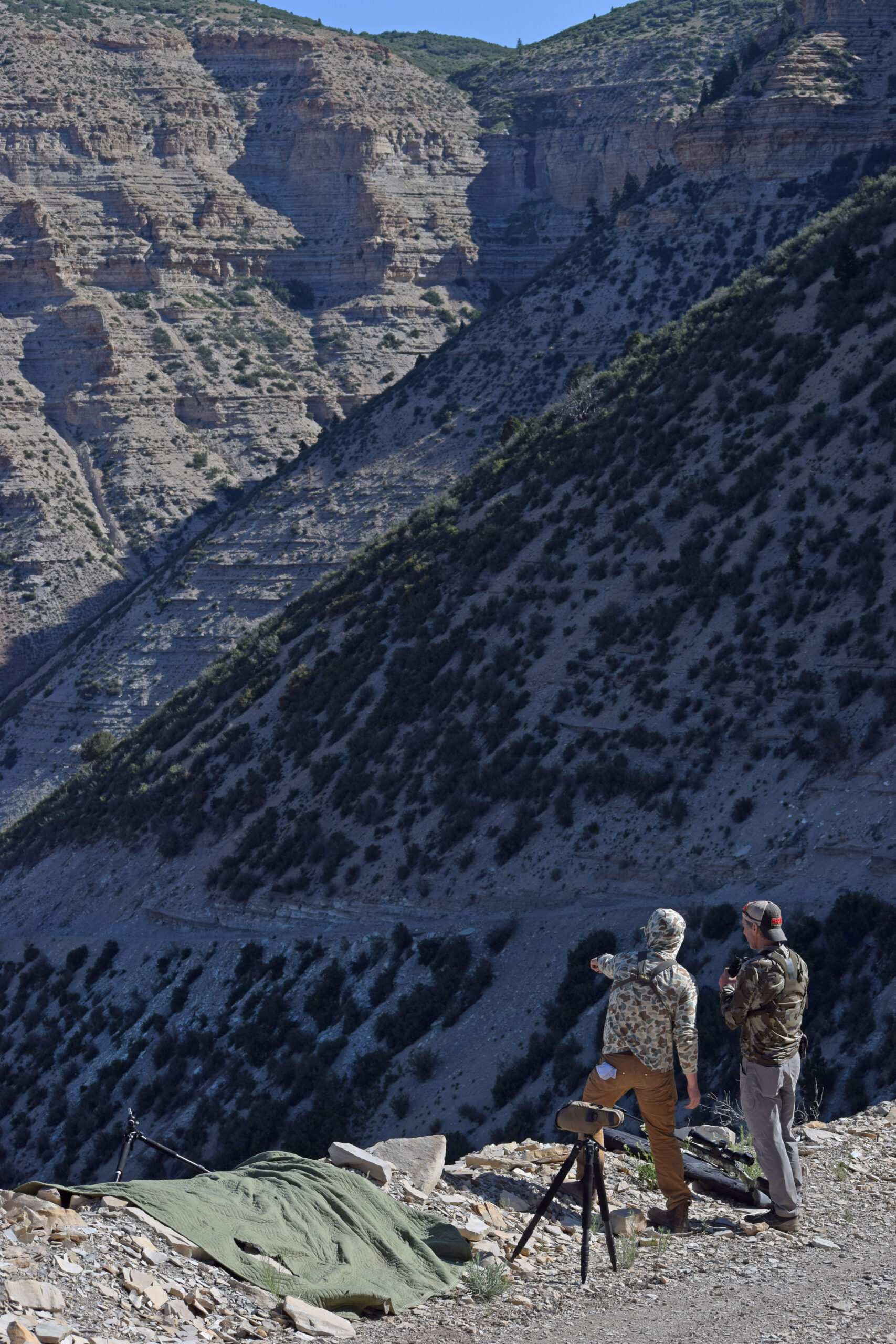
The ranges at Branded Rock Canyon near Grand Junction were full of quality steel targets strategically positioned around the canyons to challenge hunters and PRS-style shooters.
You see, we usually sight-in a rifle on a flat, horizontal range. Our zeroing takes into account the full force of gravity — from the muzzle to paper.
But when shooting up hill, gravity has fewer horizontal yards to work on the bullet. Same with a downhill shot. So, if you know it’s exactly 500 yards line-of-sight to your target, and you plan for a 500-yard shot up hill (or downhill), you’ll miss high every time.
To make that shot consistently, a cowboy back in the day could have used the so-called Rifleman’s Rule: Make your best guess of the line-of-sight distance and then guestimate the straight-ahead horizonal distance. Hold as if you were shooting the shorter, horizontal distance rather than the line-of-sight. He’d be on or darn close, if he had a lot of experience in such shooting.
“The West would have been won a lot quicker with this gear.”
To get a more accurate hold distance, he could produce a sharp pencil from his saddle bag and do some math. He would still need to estimate the line-of-sight distance and angle.
And with the angle, he could go to his handy cosine table (cosines were invented in ancient India) and multiply line-of-sight distance and the cosine of the angle to get the horizontal distance.
A 30-degree angle with a 500-yard line-of-sight distance corresponds to a .87 cosine factor on the table. Then 500 multiplied by .87 is 435. Aim as if you are shooting that far, and again, you’d be even closer on your first shot.
Thankfully, modern technology offers us tools that let us keep our pencils in our saddle bags. Instead, we can focus on making a good trigger pull while an amazing ballistic calculator puts the reticle where it needs to be.
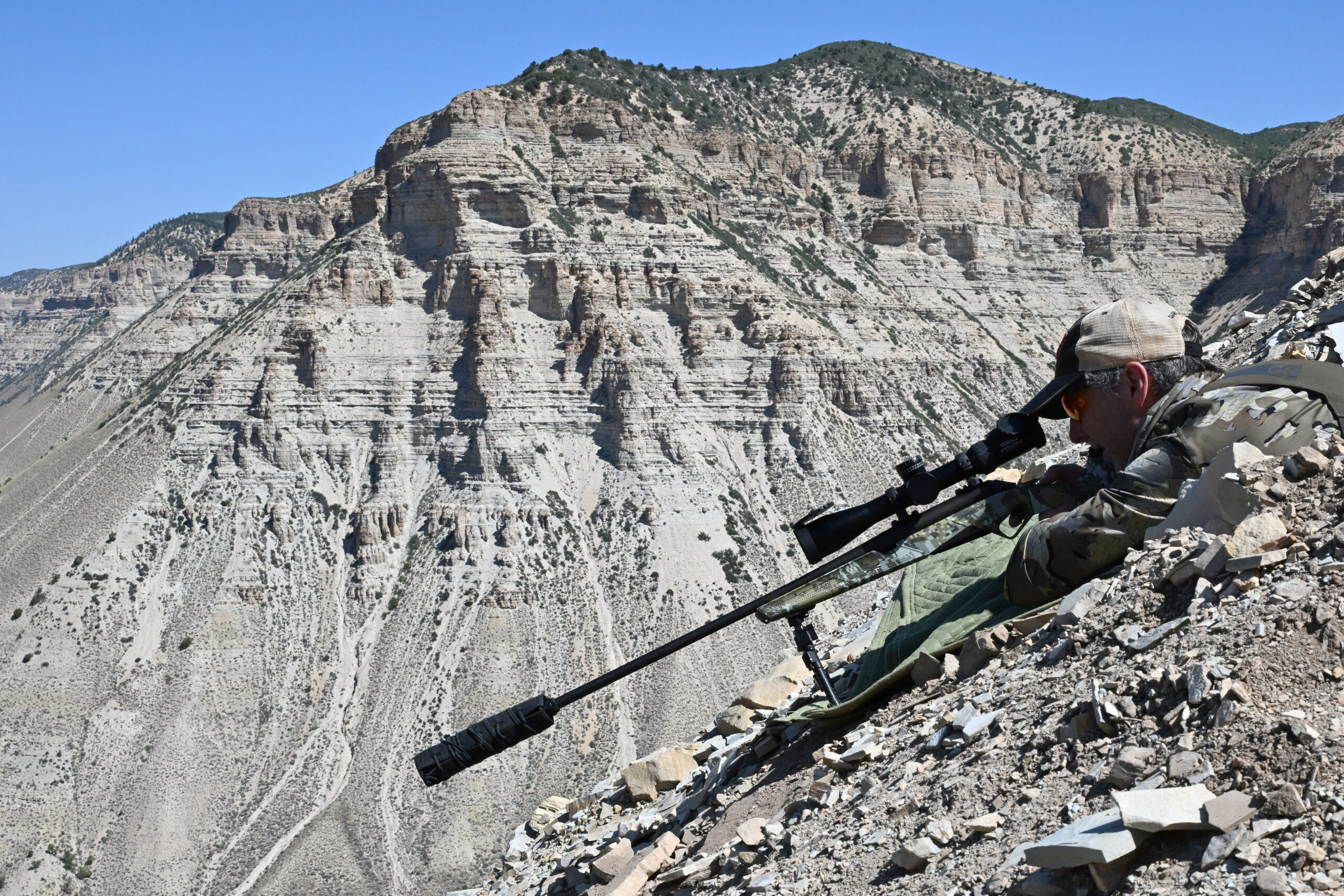 On top of my bolt-action, I had a new 3-24x50mm Steiner ePredator 8 riflescope and Steiner’s new ePredator LRF 10×42 laser-rangefinding binocular. Both helped me make the shot on the first trigger-pull.
On top of my bolt-action, I had a new 3-24x50mm Steiner ePredator 8 riflescope and Steiner’s new ePredator LRF 10×42 laser-rangefinding binocular. Both helped me make the shot on the first trigger-pull.
The scope was connected via Bluetooth to the binos, which were in the hands of friend and hunting guide Brian Jarrell.
“435 yards,” said Jarrell, who ranged the steel deer target 500 yards away and told me the angle-compensated distance.
“435 yards. Check,” I said.
That number was already displayed in my scope, thanks to the Bluetooth connection. Whenever Jarrell ranged, I could see the distance in my scope, both line-of-sight and angle-compensated. He confirmed verbally even though he didn’t have to.
Then, in less than a second, the on-board scope CPU calculated all the ballistic information I had loaded into the Steiner Connect 2 app earlier that day. It pulled in the bullet’s ballistic coefficient, weight, cartridge brand, muzzle velocity, barrel twist, barrel length, scope height, as well as real-time info, such as barometric pressure, temp and elevation local weather conditions.
I kept my cheek on the stock, eyes in the eyepiece and turned the turret until the display said it was at “435.” The crosshairs moved imperceptibly to the correct point-of-aim.
The only thing left was to judge the wind and do my part at the trigger.
“Wind hold 1 MOA left,” said Jarrell.
“1 MOA left,” I said.
“Spotter on,” said Jarrell.
“On target,” I said as I pulled the trigger in my respiratory pause.
“Impact,” said Jarrell. The vitals of the target rattled.
High fives followed.
Would a cowboy have been able to quickly hit that 12-inch plate at 500 yards with as much accuracy? Maybe.
Would I have been able to nail it on my first shot without the help of a scope and binos like these Steiners? Probably not.
Did this combo of the scope, binos, accurate ammo and a sub-MOA rifle allow me to repeat this deadly shot again and again at targets from 100 yards to 1,000?
Darn hootin’!

The ePredator LRF sends yardage data to the ePredator 8 scope in real-time. That allowed the shooter to know the distance that the guide was ranging without a word being spoken.
HEADS UP
Jarrell guides dozens of hunters every year around the Southwest. He is also the shooting instructor at Branded Rock Canyon, near Grand Junction, where we were shooting.
“Some of my clients would be very interested in this system,” he said. “The way the binos send the yardage to the client, and the fact that the client doesn’t have to look from the scope, would have been helpful on a bunch of past hunts.”
Jarrel is referring to that heads-up display. It’s one of the first things you’ll notice when you put your eye to the scope eyepiece. All the info — except windage — is there before you.
Steiner is one of a few companies that puts ballistic and environmental information from the scope and other devices directly into the eyepiece. SIG Sauer connects their KILO laser rangefinders with their scopes via their BDX system. Revic, Vortex and Burris have their systems. Each has pros and cons.
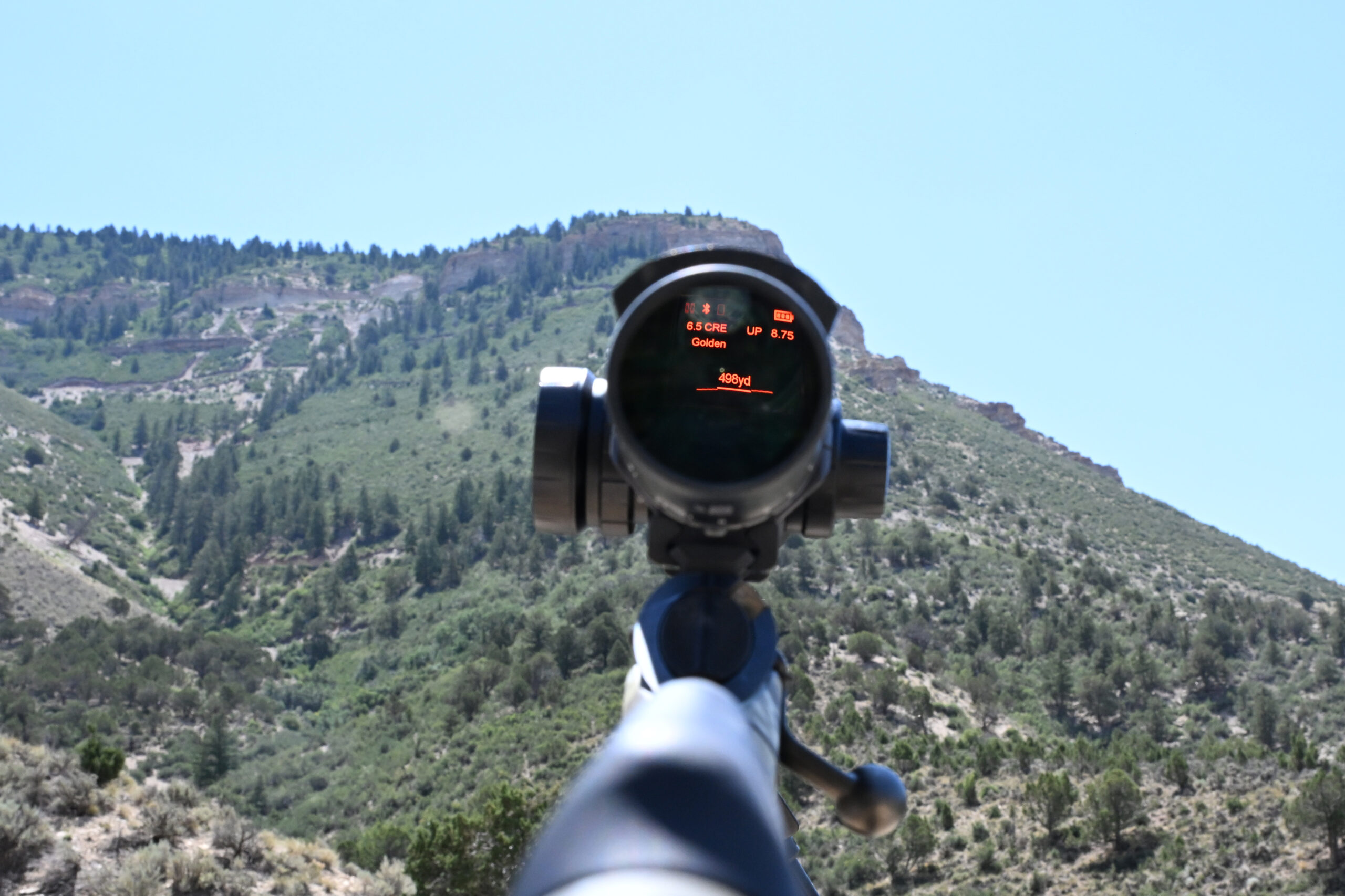
This photo gives you an idea of what the heads-up display reports to you. From top left, clockwise, it’s telling you that it is paired to the ePredator bino and phone via Bluetooth; the battery in the scope is full; if you want to dial using MOA, then dial up 8.75 MOA; 498 is your horizontal or aim-to distance; the line shows that the rifle is canted to the right; and the “6.5 CRE Golden” is the ballistic profile that I am using.
The big picture is that, as you or your guide ranges a target, that range value is sent to your head-ups display. It’s a great way to co-witness what you think your buddy is telling you. Then your scope automatically calculates your hold — no cosine or sharp pencil needed.
The display also gives you other important info, such as, the ballistic profile you are using, whether you are connected to the binos or not, whether you are connected to an app or not, what MOA you need to dial to (if you want to dial MOA), as well as the yardage either line-of-sight or angle-compensated. There is even a digital bubble level, represented by a straight line, when there is no cant.
It’s a lot, but the scope presents this info in an unobtrusive way.
That was my original trepidation about this scope and LRFs. I have used some first-gen LRF binos and scopes years ago and was disappointed at how distracting the display was. But this one is there when you need it but doesn’t distraction from your focus on the target.
You can also custom set the brightness and dim the display depending on your environmental light.
Ultimately, it is a much better solution than having to pick your head up to see the numbers on your turret as you dial. That’s especially true for someone like me who is far-sighted. I can keep my cheek welded to the stock and make adjustments to yardage and parallax while looking through the scope. That’s worth the price of admission right there.
IMPACT LOCATOR
While that heads-up display and on-board computer help you make the shot, there is also extraordinary tech to lead you to your target after the shot.
When Jarrell ranged that target, the binos stored the last three ranges. So, if I hit my target animal while hunting, the binos would know the exact distance. The binos can use the scope’s onboard digital compass and angle setting, and drop a pin on a Google map in your phone. You can then navigate to the spot as easy as walking to a Starbuck’s in a city.
Steiner calls this feature “Impact Locator.” Rumor has it that it will soon work with third party mapping apps as well.
If you are away from signal or wi-fi, download an offline Google map before your trip. Then you can have it on your phone wherever you go.
Impact Locator can be invaluable, especially on longer shots. Things always look a lot different when you are looking back to where you shot from. The feature is a great tool to help you recover game efficiently. Imagine hunting in tall grass in Africa, the undulating Missouri Breaks or the wandering hills of Appalachia. Impact Locator could sure come in handy before you find that blood trail.
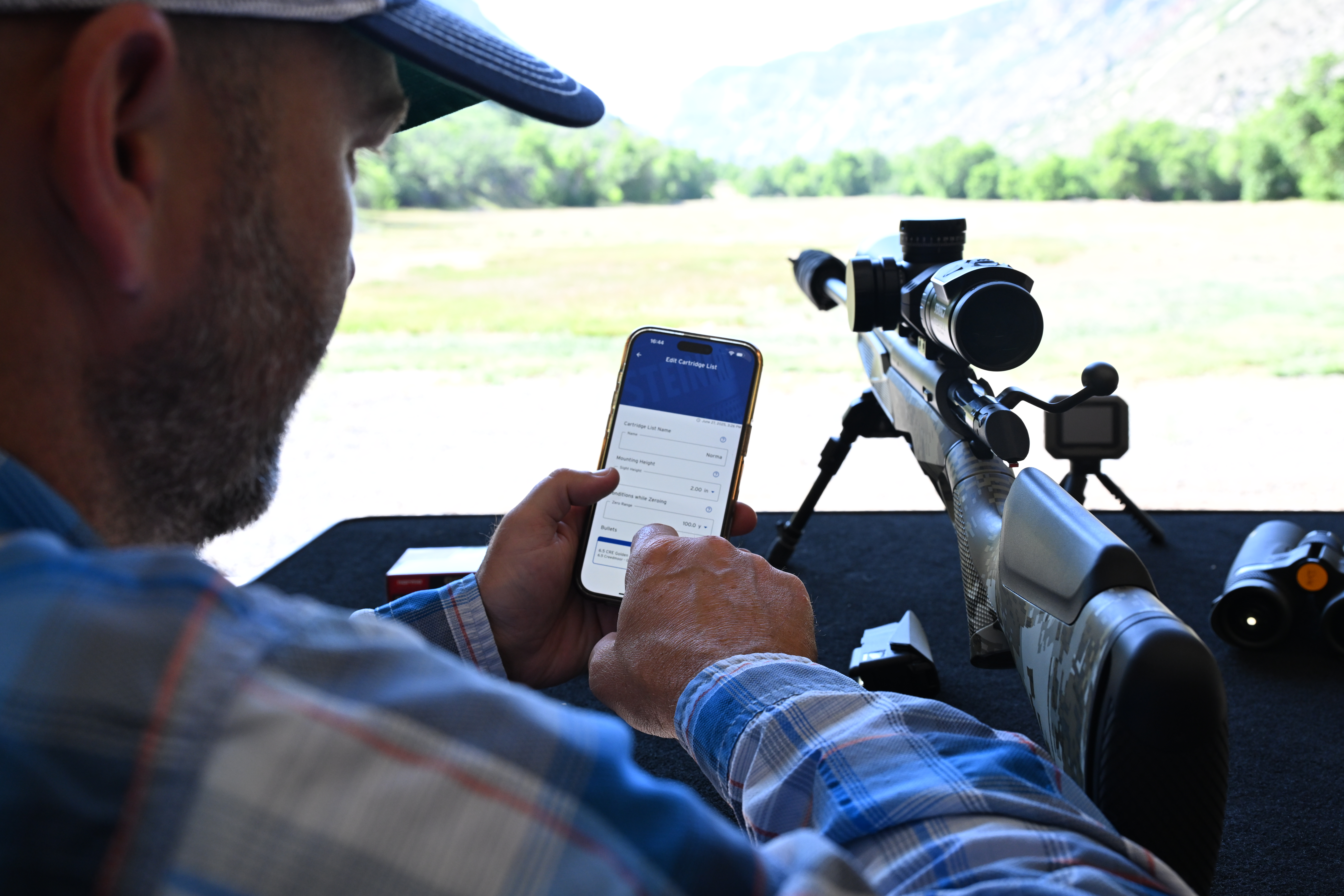
Shooters entered their ballistic data — muzzle velocity, bullet ballistic coefficient and other info — into the Steiner Connection 2 app and then loaded that ballistic profile into the ePredator 8 scope.
The binos also range to impressive 3,000 meters (3,280 yards), and they have three ranging features that you can change depending on your conditions.
A Close Priority mode prioritizes items in the foreground, which would make it effective for bowhunting and turkey hunting. The Far Priority blocks out nearby targets and is the better mode for longer-range shooting. And the All-Weather mode will help you range more accurately in rain or snow.
The ePredator LRF binos weigh-in at 39 ounces, which is impressive for a 10×42 with an on-board LRF. They are a reasonably compact 8.2 inches long.
The glass compared very well to top brands in this category during our low-light comparison. The ePredator LRF binos penetrated deep into dark woods as well or better than similar in-class 10×42 rangefinding binos.
The MSRP for the binos is $1,954, but they are $1,799 at Steiner-optic.com.
SCOPE SPECS
The second focal plane ePredator 8 riflescope has a generous 3.7 inches of eye relief. It weighed in at 34.46 ounces, which is heavier for a 3-24×50, but again, there is a lot of on-board technology that many other scopes do not have.
This scope is legal for shooting everywhere but not so for hunting. Some states restrict the electronics you can have in a scope while hunting. In fact, in Colorado, where I tested out this system, I could not legally hunt with it.
Check state or provincial regulations before topping your rifle with the ePredator 8 scope.
The simple reticle has a fiber dot, a fine red-dot aiming point. If batteries fail, there are drop-compensating hash marks on the reticle so you can use the scope in any condition.
“I can make adjustments to the yardage and parallax turrets while keeping my cheek weld and looking through the scope. That’s worth the price of admission right there.”
Elevation turret as well as windage and elevation adjustments were precise.
The scope is currently available only in 8-magnification, 3-24x54mm. MSRP is $3,259.
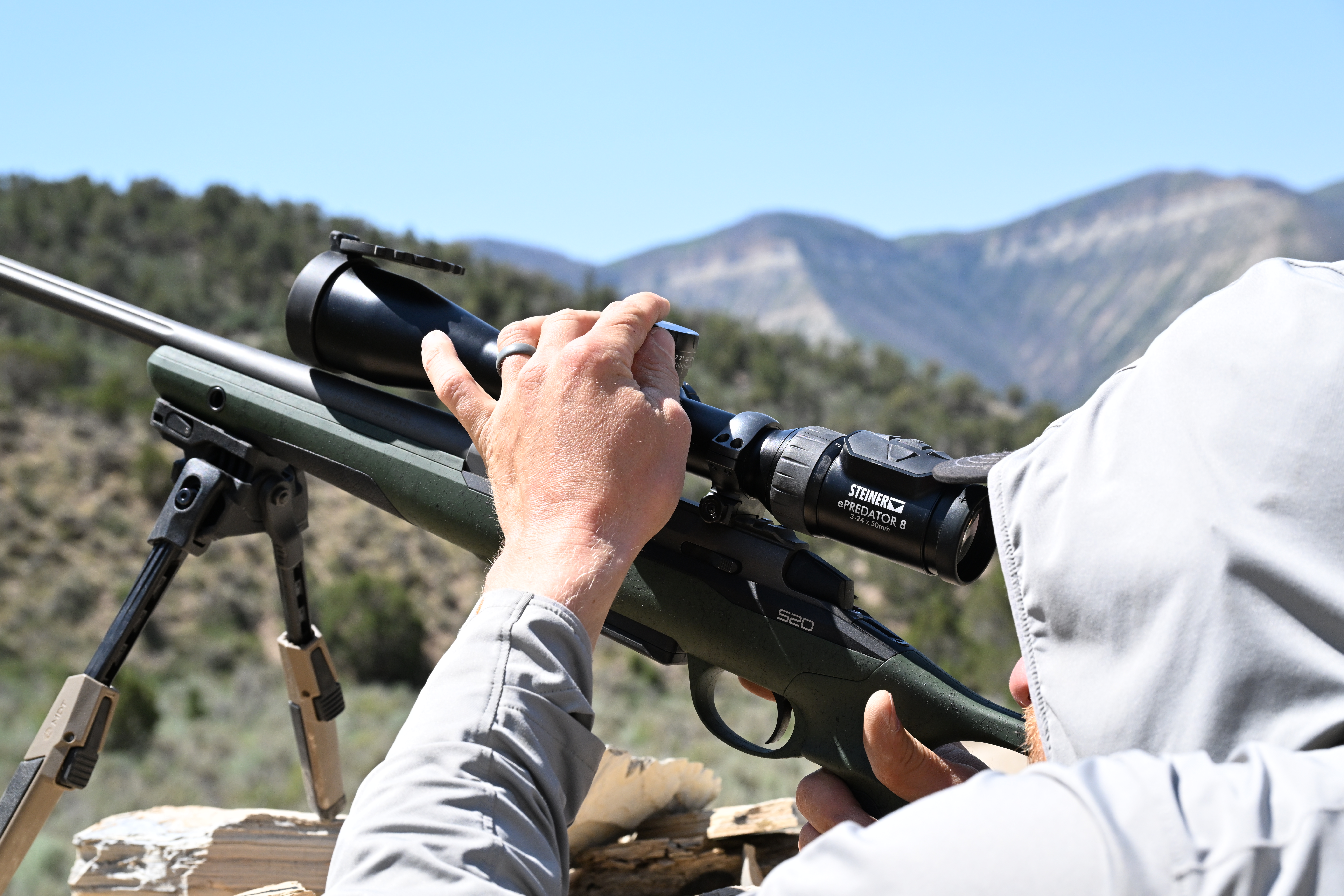
Notice how shooter Brad Faulstitch’s hand is in on the elevation turret dialing, yet his eye is in the scope. This is a big part of what makes the ePredator 8 impressive: There is no need to pick you head up and look at the turret to change elevation or to adjust parallax. Brilliant.
Gratefully, Steiner uses a 34mm tube, which allows shooters to dial to distances past 1,000 with high-BC, flat-shooting bullets. We shot Norma Golden Target in 6.5 Creedmoor, which were highly consistent. I chronoed my range shooting and velocity varied only about 10 FPS in the same lot.
One note about long-distance shooting: Technology has allowed us to accurately shoot out to extremely long distances. Shooting long distances at targets, like my steel deer, is challenging and exciting.
However, when it comes to shooting live animals, first you need to be the best stalker you can be. Then, the best shooter you can be.
Get as close as possible to your target. Know the ethical limit of your gear before pulling the trigger. When will your bullet go subsonic and lose accuracy? When will it drop below 1,000 foot-pounds of energy and not penetrate well? Are you good at reading mirage? You need to know these things.
Remember, practice your technique, learn your gear and shoot long-distance at the range. Then you will be much more confident with a closer shot. Ringing steel at 900 yards will increase your chances of finding vitals at 300 yards.
COWBOY ACTION
Whether shooting an outlaw or a deer for dinner, yes, that 19th century cowboy could calculate out a steep, accurate, long-distance hold for his all-important cold-barrel shot.
As for you and me, it’s good for us to be able to do it manually as well. Technology has bugs. Batteries fail. Data input isn’t always accurate. And communication errors happen.
With practice, learning your gear at the range and investing in excellent technology, innovation can also help you repeat difficult shots again and again with impact and high fives.
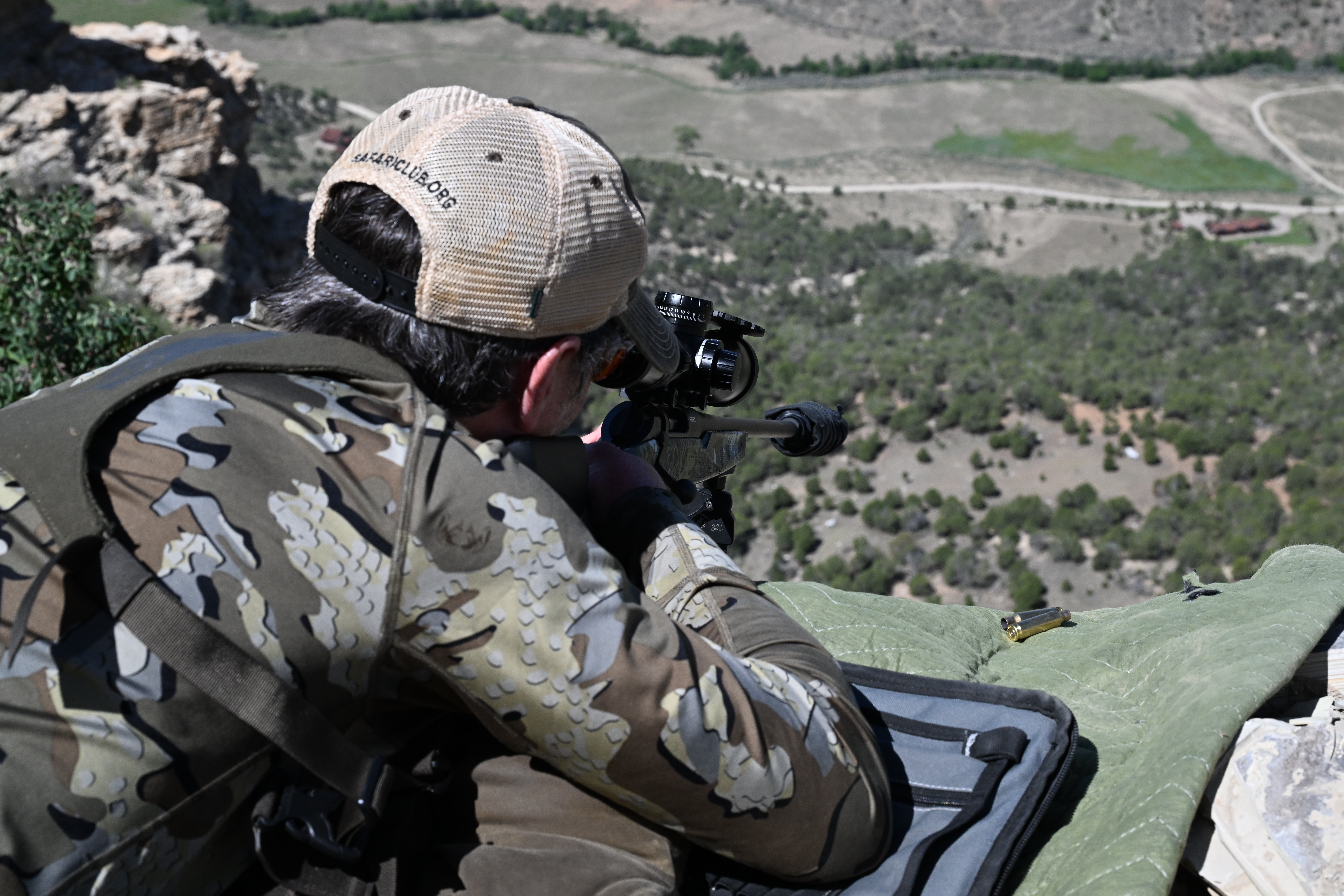
If you use line-of-sight yardage on a sever uphill or downhill shot, you’ll shoot high every time. That white dot on the canyon floor is a full-sized moose steel target at 440 yards.

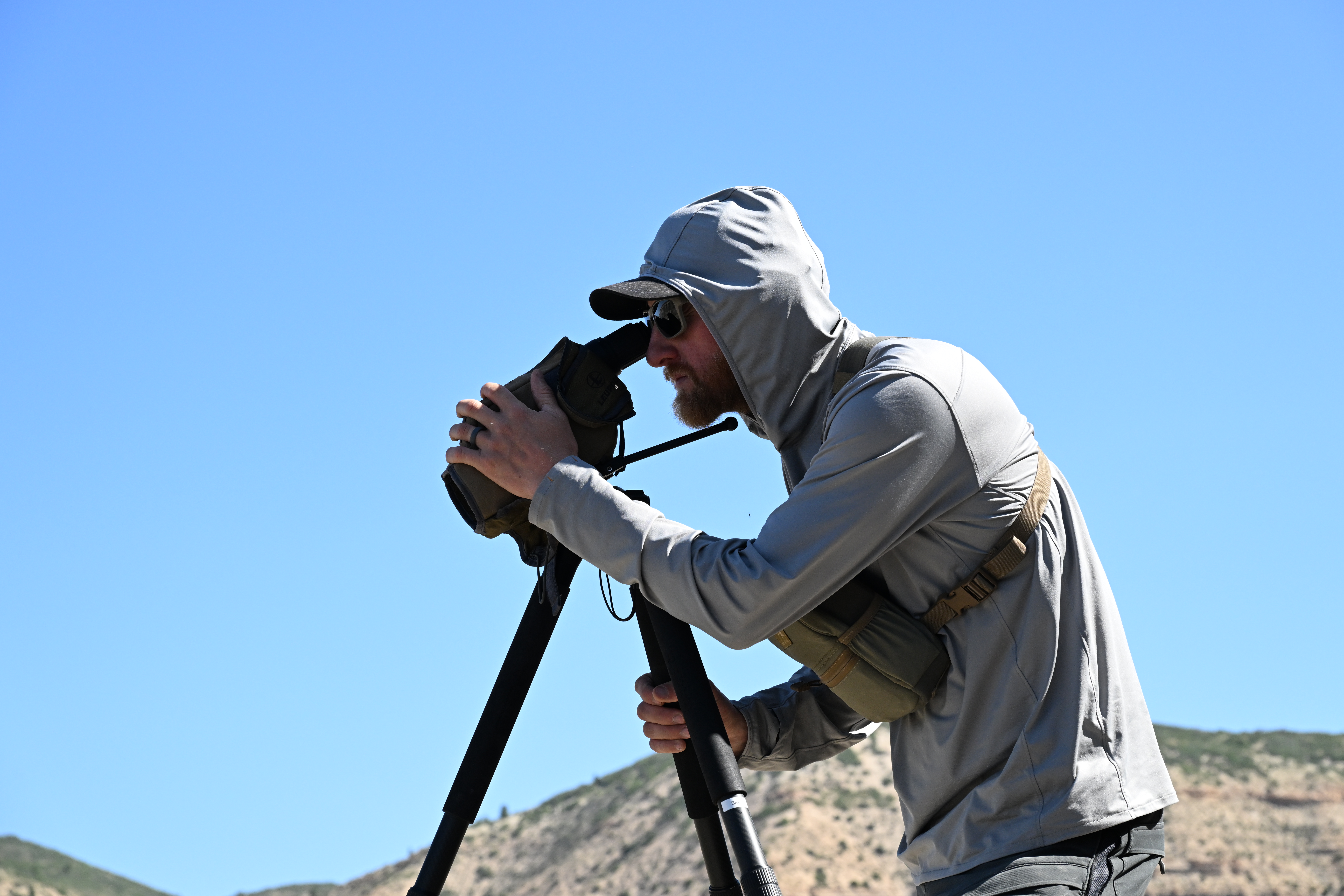
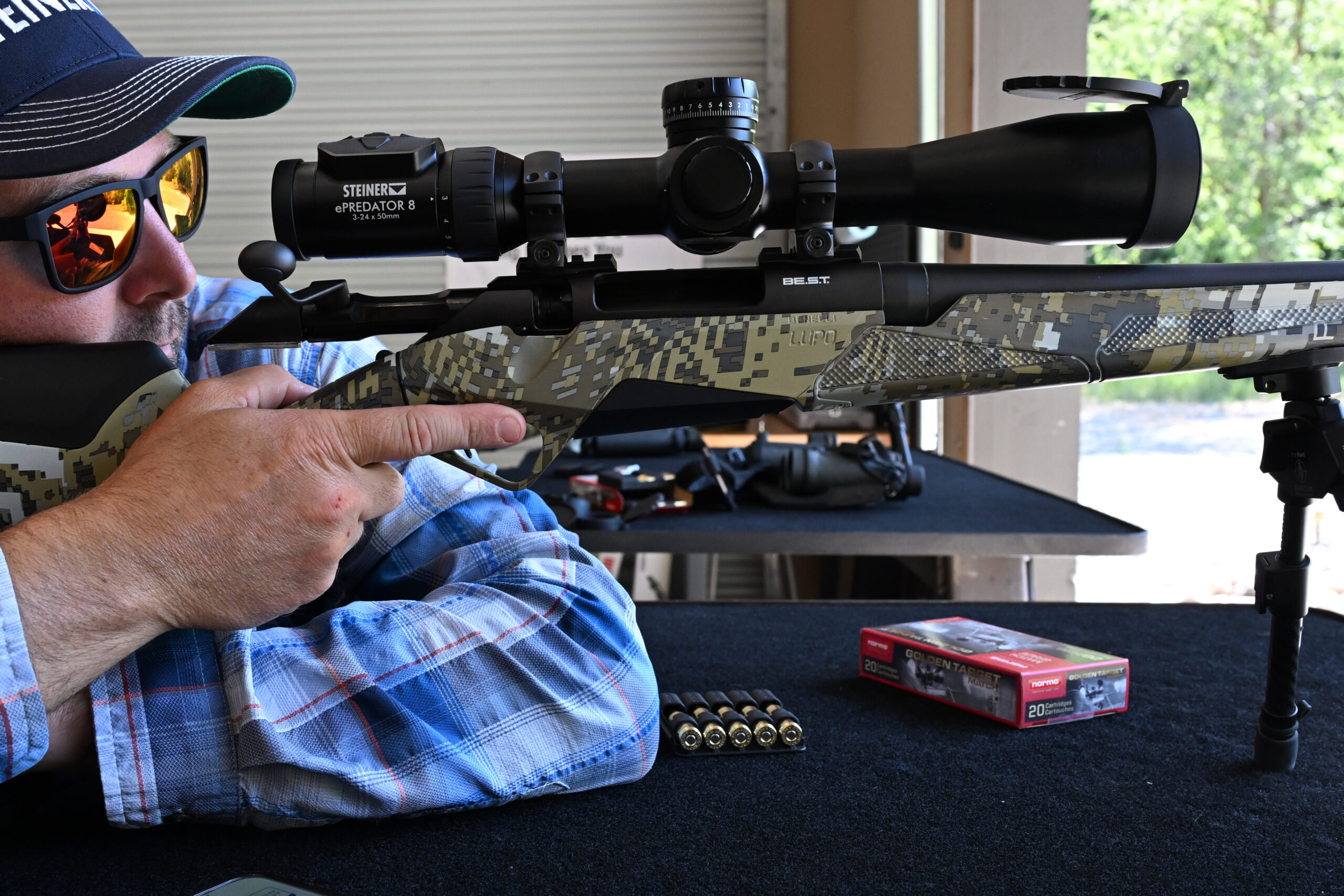
The new ePredator 3-24×50 has a 34mm tube for lots of vertical adjustment and has 3.7 inches of eye relief. It weighs 34.46 ounces, which is on the heavier side for a 3-24×50. But then again, there is a lot of on-board technology that many other scopes do not have.

Shooters entered their ballistic data — muzzle velocity, bullet ballistic coefficient and other info — into the Steiner Connection 2 app and then loaded that ballistic profile into the ePredator scope.
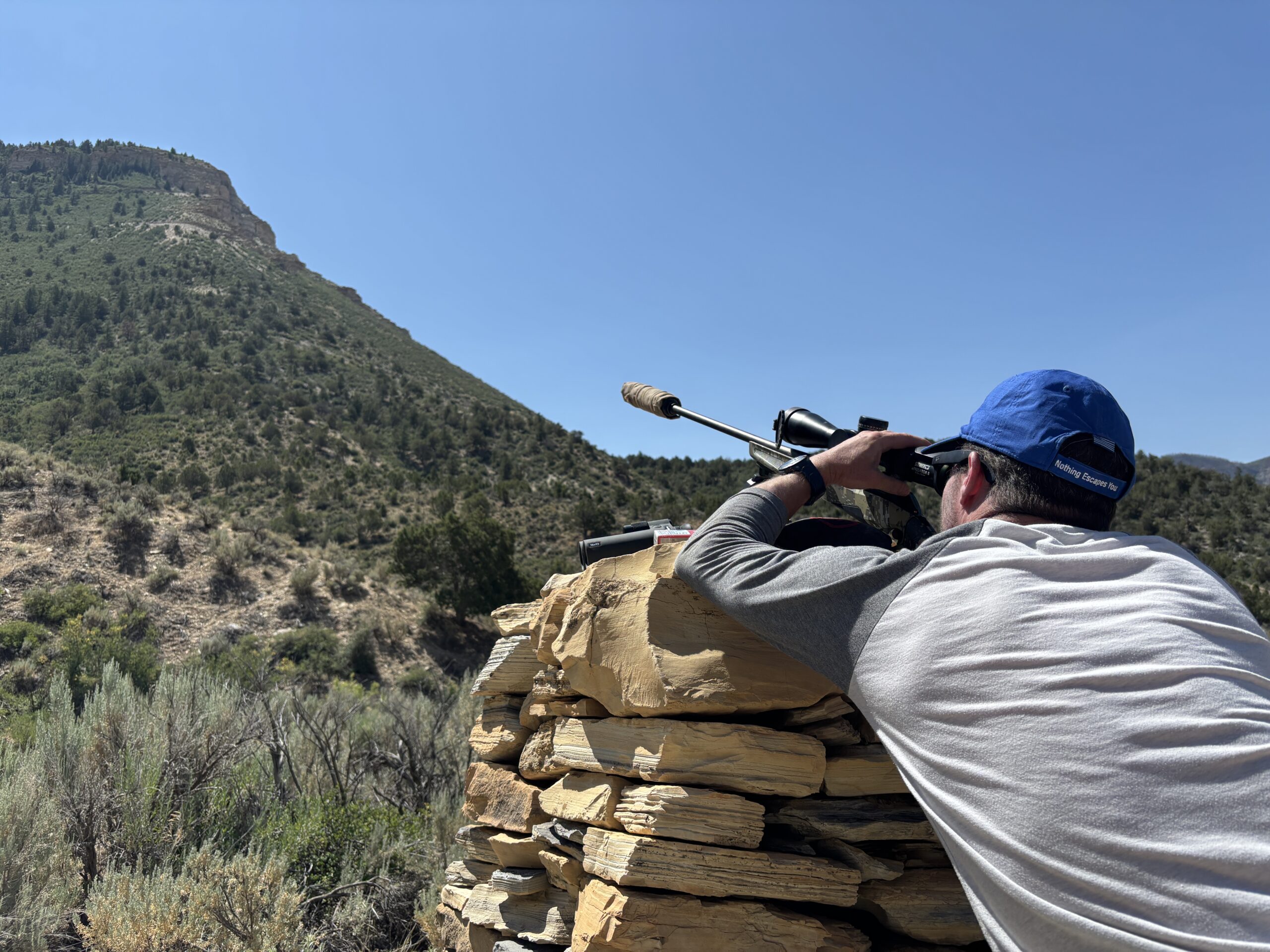
Nailing a steep uphill shot on your first trigger pull calls for dumb luck, college-level math or technology, like you find in the guts of Steiner’s new ePredator scope and laser rangefinding binos.

